warning light FIAT DUCATO BASE CAMPER 2015 Owner handbook (in English)
[x] Cancel search | Manufacturer: FIAT, Model Year: 2015, Model line: DUCATO BASE CAMPER, Model: FIAT DUCATO BASE CAMPER 2015Pages: 367, PDF Size: 19.73 MB
Page 52 of 367
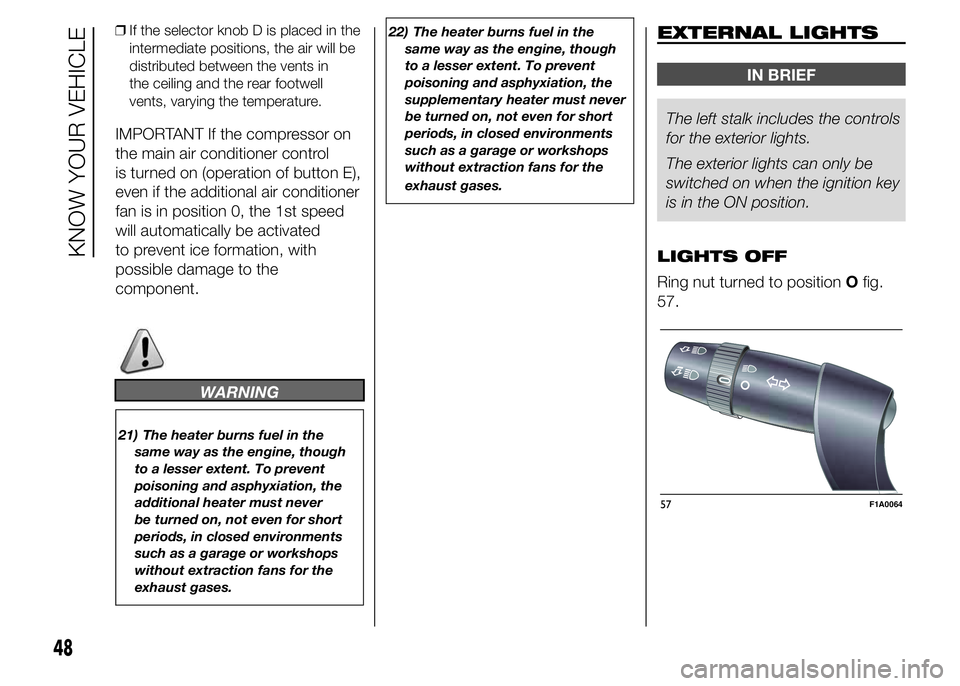
IMPORTANT If the compressor on
the main air conditioner control
is turned on (operation of button E),
even if the additional air conditioner
fan is in position 0, the 1st speed
will automatically be activated
to prevent ice formation, with
possible damage to the
component.
WARNING
21) The heater burns fuel in the
same way as the engine, though
to a lesser extent. To prevent
poisoning and asphyxiation, the
additional heater must never
be turned on, not even for short
periods, in closed environments
such as a garage or workshops
without extraction fans for the
exhaust gases.22) The heater burns fuel in the
same way as the engine, though
to a lesser extent. To prevent
poisoning and asphyxiation, the
supplementary heater must never
be turned on, not even for short
periods, in closed environments
such as a garage or workshops
without extraction fans for the
exhaust gases.
EXTERNAL LIGHTS
IN BRIEF
The left stalk includes the controls
for the exterior lights.
The exterior lights can only be
switched on when the ignition key
is in the ON position.
LIGHTS OFF
Ring nut turned to positionOfig.
57.
57F1A0064
48
KNOW YOUR VEHICLE
❒If the selector knob D is placed in the
intermediate positions, the air will be
distributed between the vents in
the ceiling and the rear footwell
vents, varying the temperature.
Page 53 of 367
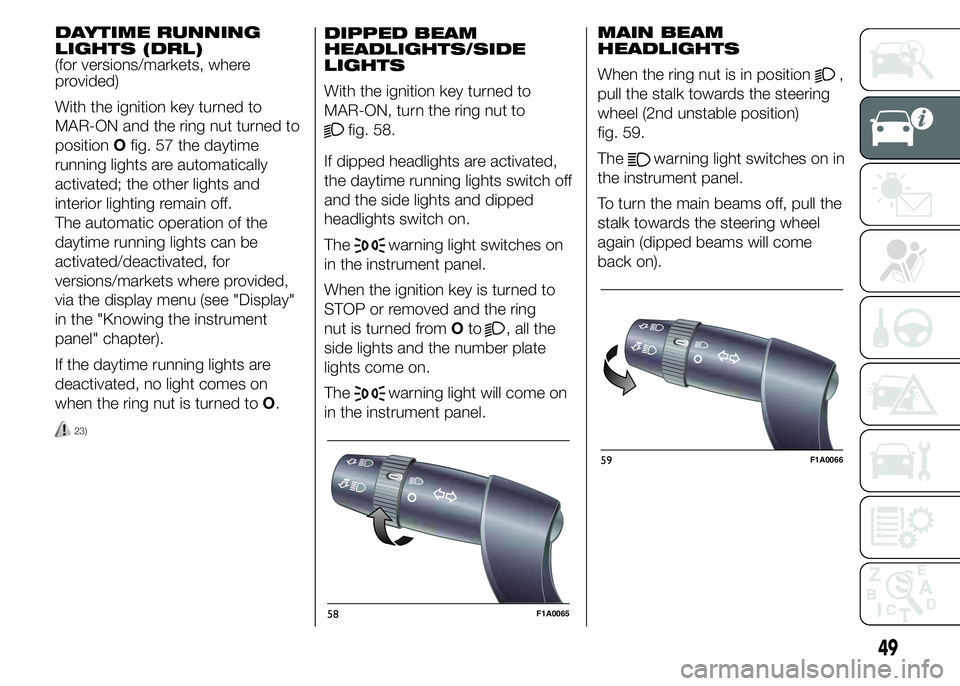
DAYTIME RUNNING
LIGHTS (DRL)
(for versions/markets, where
provided)
With the ignition key turned to
MAR-ON and the ring nut turned to
positionOfig. 57 the daytime
running lights are automatically
activated; the other lights and
interior lighting remain off.
The automatic operation of the
daytime running lights can be
activated/deactivated, for
versions/markets where provided,
via the display menu (see "Display"
in the "Knowing the instrument
panel" chapter).
If the daytime running lights are
deactivated, no light comes on
when the ring nut is turned toO.
23)
DIPPED BEAM
HEADLIGHTS/SIDE
LIGHTS
With the ignition key turned to
MAR-ON, turn the ring nut to
fig. 58.
If dipped headlights are activated,
the daytime running lights switch off
and the side lights and dipped
headlights switch on.
The
warning light switches on
in the instrument panel.
When the ignition key is turned to
STOP or removed and the ring
nut is turned fromOto
, all the
side lights and the number plate
lights come on.
The
warning light will come on
in the instrument panel.MAIN BEAM
HEADLIGHTS
When the ring nut is in position
,
pull the stalk towards the steering
wheel (2nd unstable position)
fig. 59.
The
warning light switches on in
the instrument panel.
To turn the main beams off, pull the
stalk towards the steering wheel
again (dipped beams will come
back on).
58F1A0065
59F1A0066
49
Page 54 of 367
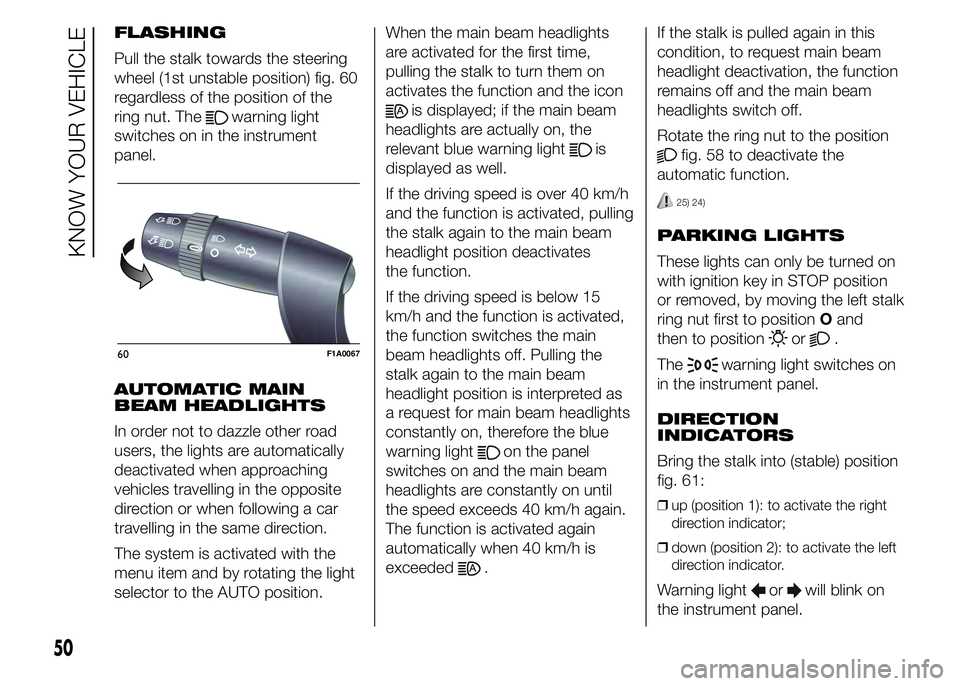
FLASHING
Pull the stalk towards the steering
wheel (1st unstable position) fig. 60
regardless of the position of the
ring nut. The
warning light
switches on in the instrument
panel.
AUTOMATIC MAIN
BEAM HEADLIGHTS
In order not to dazzle other road
users, the lights are automatically
deactivated when approaching
vehicles travelling in the opposite
direction or when following a car
travelling in the same direction.
The system is activated with the
menu item and by rotating the light
selector to the AUTO position.When the main beam headlights
are activated for the first time,
pulling the stalk to turn them on
activates the function and the iconis displayed; if the main beam
headlights are actually on, the
relevant blue warning light
is
displayed as well.
If the driving speed is over 40 km/h
and the function is activated, pulling
the stalk again to the main beam
headlight position deactivates
the function.
If the driving speed is below 15
km/h and the function is activated,
the function switches the main
beam headlights off. Pulling the
stalk again to the main beam
headlight position is interpreted as
a request for main beam headlights
constantly on, therefore the blue
warning light
on the panel
switches on and the main beam
headlights are constantly on until
the speed exceeds 40 km/h again.
The function is activated again
automatically when 40 km/h is
exceeded
.If the stalk is pulled again in this
condition, to request main beam
headlight deactivation, the function
remains off and the main beam
headlights switch off.
Rotate the ring nut to the position
fig. 58 to deactivate the
automatic function.
25) 24)
PARKING LIGHTS
These lights can only be turned on
with ignition key in STOP position
or removed, by moving the left stalk
ring nut first to positionOand
then to position
or.
The
warning light switches on
in the instrument panel.
DIRECTION
INDICATORS
Bring the stalk into (stable) position
fig. 61:
❒up (position 1): to activate the right
direction indicator;
❒down (position 2): to activate the left
direction indicator.
Warning lightorwill blink on
the instrument panel.
60F1A0067
50
KNOW YOUR VEHICLE
Page 55 of 367
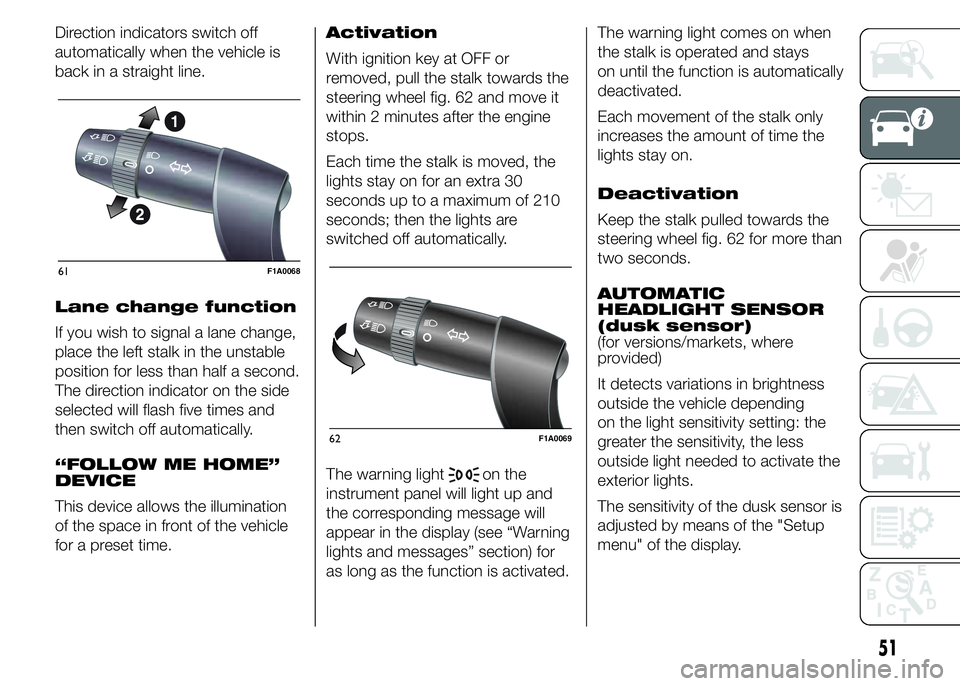
Direction indicators switch off
automatically when the vehicle is
back in a straight line.
Lane change function
If you wish to signal a lane change,
place the left stalk in the unstable
position for less than half a second.
The direction indicator on the side
selected will flash five times and
then switch off automatically.
“FOLLOW ME HOME”
DEVICE
This device allows the illumination
of the space in front of the vehicle
for a preset time.Activation
With ignition key at OFF or
removed, pull the stalk towards the
steering wheel fig. 62 and move it
within 2 minutes after the engine
stops.
Each time the stalk is moved, the
lights stay on for an extra 30
seconds up to a maximum of 210
seconds; then the lights are
switched off automatically.
The warning light
on the
instrument panel will light up and
the corresponding message will
appear in the display (see “Warning
lights and messages” section) for
as long as the function is activated.The warning light comes on when
the stalk is operated and stays
on until the function is automatically
deactivated.
Each movement of the stalk only
increases the amount of time the
lights stay on.
Deactivation
Keep the stalk pulled towards the
steering wheel fig. 62 for more than
two seconds.
AUTOMATIC
HEADLIGHT SENSOR
(dusk sensor)
(for versions/markets, where
provided)
It detects variations in brightness
outside the vehicle depending
on the light sensitivity setting: the
greater the sensitivity, the less
outside light needed to activate the
exterior lights.
The sensitivity of the dusk sensor is
adjusted by means of the "Setup
menu" of the display.
61F1A0068
62F1A0069
51
Page 56 of 367
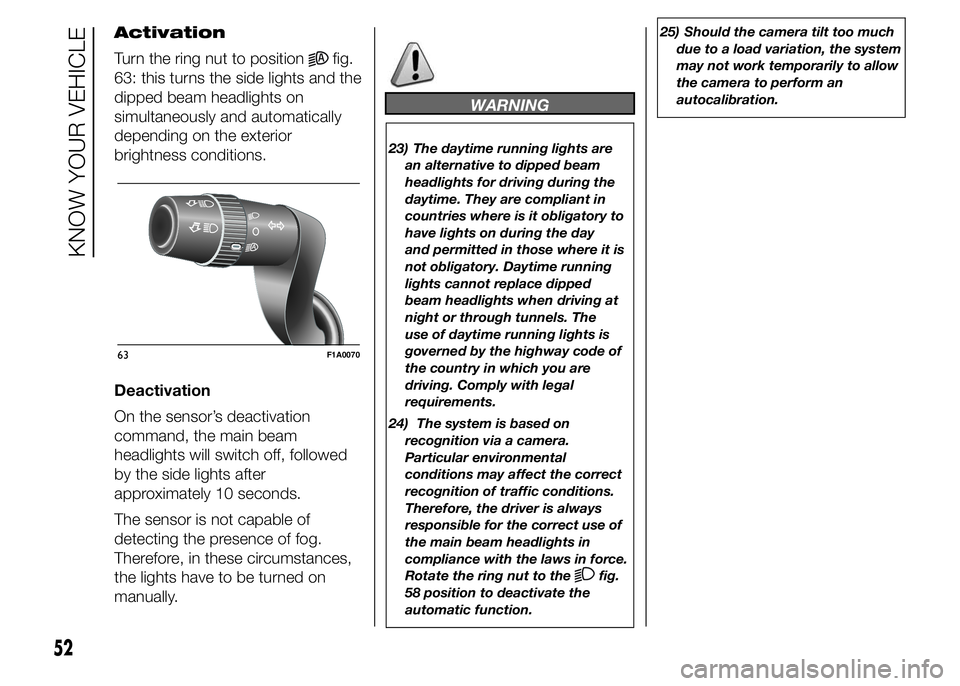
Activation
Turn the ring nut to position
fig.
63: this turns the side lights and the
dipped beam headlights on
simultaneously and automatically
depending on the exterior
brightness conditions.
Deactivation
On the sensor’s deactivation
command, the main beam
headlights will switch off, followed
by the side lights after
approximately 10 seconds.
The sensor is not capable of
detecting the presence of fog.
Therefore, in these circumstances,
the lights have to be turned on
manually.
WARNING
23) The daytime running lights are
an alternative to dipped beam
headlights for driving during the
daytime. They are compliant in
countries where is it obligatory to
have lights on during the day
and permitted in those where it is
not obligatory. Daytime running
lights cannot replace dipped
beam headlights when driving at
night or through tunnels. The
use of daytime running lights is
governed by the highway code of
the country in which you are
driving. Comply with legal
requirements.
24) The system is based on
recognition via a camera.
Particular environmental
conditions may affect the correct
recognition of traffic conditions.
Therefore, the driver is always
responsible for the correct use of
the main beam headlights in
compliance with the laws in force.
Rotate the ring nut to the
fig.
58 position to deactivate the
automatic function.25) Should the camera tilt too much
due to a load variation, the system
may not work temporarily to allow
the camera to perform an
autocalibration.
63F1A0070
52
KNOW YOUR VEHICLE
Page 59 of 367
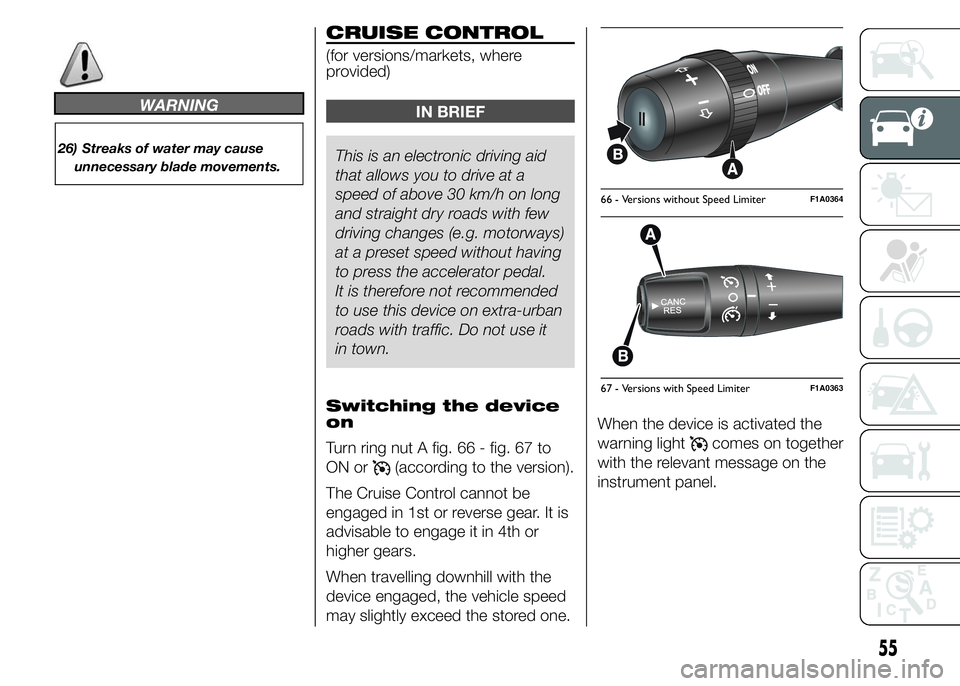
WARNING
26) Streaks of water may cause
unnecessary blade movements.
CRUISE CONTROL
(for versions/markets, where
provided)
IN BRIEF
This is an electronic driving aid
that allows you to drive at a
speed of above 30 km/h on long
and straight dry roads with few
driving changes (e.g. motorways)
at a preset speed without having
to press the accelerator pedal.
It is therefore not recommended
to use this device on extra-urban
roads with traffic. Do not use it
in town.
Switching the device
on
Turn ring nut A fig. 66 - fig. 67 to
ON or
(according to the version).
The Cruise Control cannot be
engaged in 1st or reverse gear. It is
advisable to engage it in 4th or
higher gears.
When travelling downhill with the
device engaged, the vehicle speed
may slightly exceed the stored one.When the device is activated the
warning light
comes on together
with the relevant message on the
instrument panel.
66 - Versions without Speed LimiterF1A0364
67 - Versions with Speed LimiterF1A0363
55
Page 61 of 367
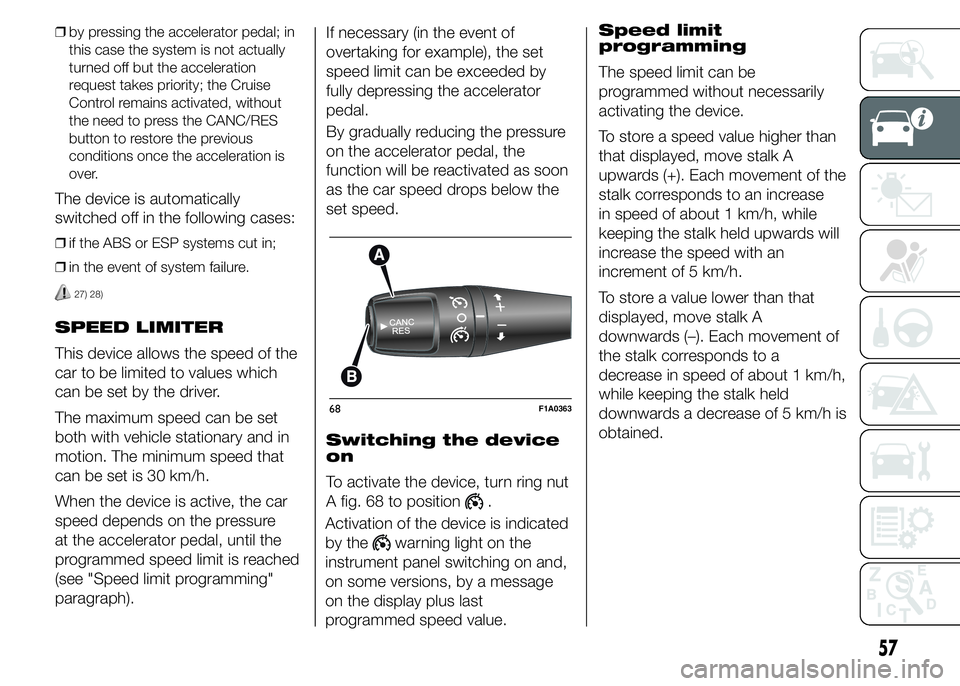
❒by pressing the accelerator pedal; in
this case the system is not actually
turned off but the acceleration
request takes priority; the Cruise
Control remains activated, without
the need to press the CANC/RES
button to restore the previous
conditions once the acceleration is
over.
The device is automatically
switched off in the following cases:
❒if the ABS or ESP systems cut in;
❒in the event of system failure.
27) 28)
SPEED LIMITER
This device allows the speed of the
car to be limited to values which
can be set by the driver.
The maximum speed can be set
both with vehicle stationary and in
motion. The minimum speed that
can be set is 30 km/h.
When the device is active, the car
speed depends on the pressure
at the accelerator pedal, until the
programmed speed limit is reached
(see "Speed limit programming"
paragraph).If necessary (in the event of
overtaking for example), the set
speed limit can be exceeded by
fully depressing the accelerator
pedal.
By gradually reducing the pressure
on the accelerator pedal, the
function will be reactivated as soon
as the car speed drops below the
set speed.
Switching the device
on
To activate the device, turn ring nut
A fig. 68 to position
.
Activation of the device is indicated
by the
warning light on the
instrument panel switching on and,
on some versions, by a message
on the display plus last
programmed speed value.Speed limit
programming
The speed limit can be
programmed without necessarily
activating the device.
To store a speed value higher than
that displayed, move stalk A
upwards (+). Each movement of the
stalk corresponds to an increase
in speed of about 1 km/h, while
keeping the stalk held upwards will
increase the speed with an
increment of 5 km/h.
To store a value lower than that
displayed, move stalk A
downwards (–). Each movement of
the stalk corresponds to a
decrease in speed of about 1 km/h,
while keeping the stalk held
downwards a decrease of 5 km/h is
obtained.
68F1A0363
57
Page 62 of 367
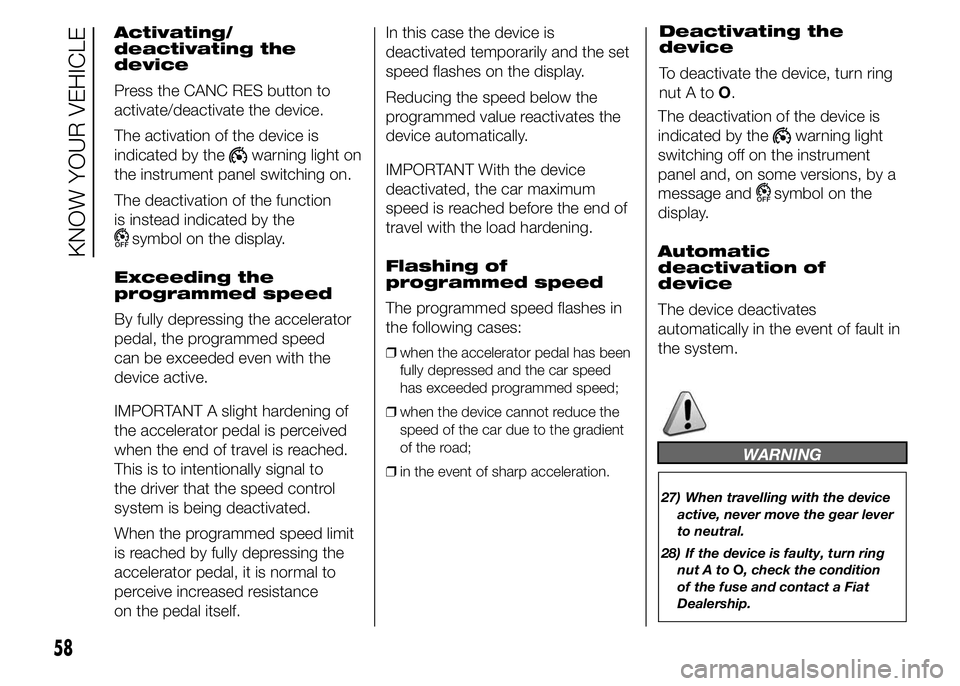
Activating/
deactivating the
device
Press the CANC RES button to
activate/deactivate the device.
The activation of the device is
indicated by the
warning light on
the instrument panel switching on.
The deactivation of the function
is instead indicated by the
symbol on the display.
Exceeding the
programmed speed
By fully depressing the accelerator
pedal, the programmed speed
can be exceeded even with the
device active.
IMPORTANT A slight hardening of
the accelerator pedal is perceived
when the end of travel is reached.
This is to intentionally signal to
the driver that the speed control
system is being deactivated.
When the programmed speed limit
is reached by fully depressing the
accelerator pedal, it is normal to
perceive increased resistance
on the pedal itself.In this case the device is
deactivated temporarily and the set
speed flashes on the display.
Reducing the speed below the
programmed value reactivates the
device automatically.
IMPORTANT With the device
deactivated, the car maximum
speed is reached before the end of
travel with the load hardening.
Flashing of
programmed speed
The programmed speed flashes in
the following cases:
❒when the accelerator pedal has been
fully depressed and the car speed
has exceeded programmed speed;
❒when the device cannot reduce the
speed of the car due to the gradient
of the road;
❒in the event of sharp acceleration.
Deactivating the
device
To deactivate the device, turn ring
nutAtoO.
The deactivation of the device is
indicated by the
warning light
switching off on the instrument
panel and, on some versions, by a
message and
symbol on the
display.
Automatic
deactivation of
device
The device deactivates
automatically in the event of fault in
the system.
WARNING
27) When travelling with the device
active, never move the gear lever
to neutral.
28) If the device is faulty, turn ring
nutAtoO, check the condition
of the fuse and contact a Fiat
Dealership.
58
KNOW YOUR VEHICLE
Page 64 of 367
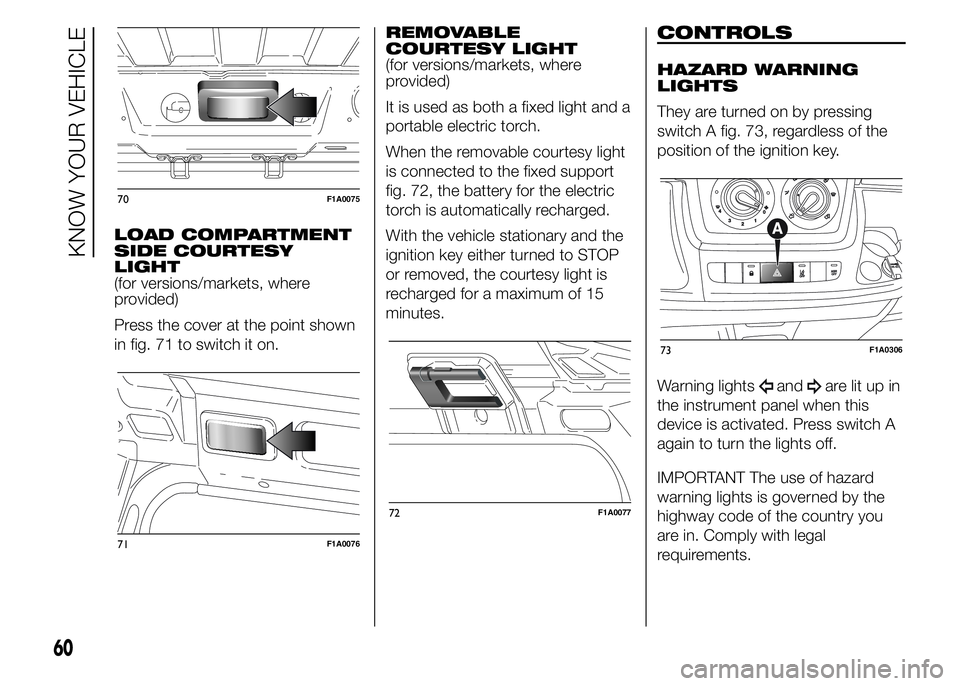
LOAD COMPARTMENT
SIDE COURTESY
LIGHT
(for versions/markets, where
provided)
Press the cover at the point shown
in fig. 71 to switch it on.REMOVABLE
COURTESY LIGHT
(for versions/markets, where
provided)
It is used as both a fixed light and a
portable electric torch.
When the removable courtesy light
is connected to the fixed support
fig. 72, the battery for the electric
torch is automatically recharged.
With the vehicle stationary and the
ignition key either turned to STOP
or removed, the courtesy light is
recharged for a maximum of 15
minutes.
CONTROLS
HAZARD WARNING
LIGHTS
They are turned on by pressing
switch A fig. 73, regardless of the
position of the ignition key.
Warning lights
andare lit up in
the instrument panel when this
device is activated. Press switch A
again to turn the lights off.
IMPORTANT The use of hazard
warning lights is governed by the
highway code of the country you
are in. Comply with legal
requirements.
70F1A0075
71F1A0076
72F1A0077
73F1A0306
60
KNOW YOUR VEHICLE
Page 65 of 367
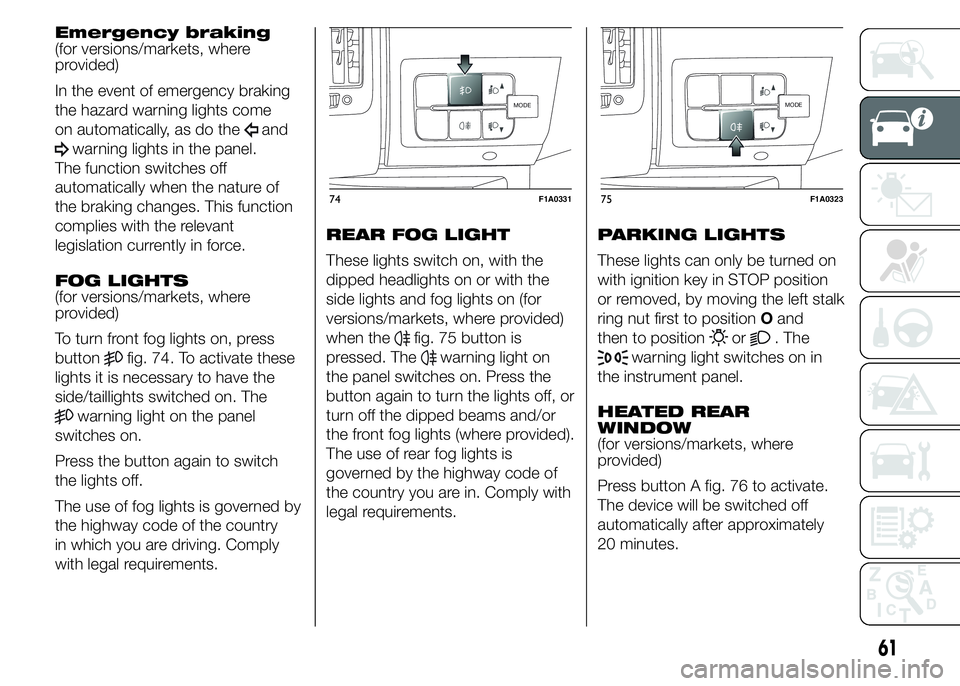
Emergency braking
(for versions/markets, where
provided)
In the event of emergency braking
the hazard warning lights come
on automatically, as do the
and
warning lights in the panel.
The function switches off
automatically when the nature of
the braking changes. This function
complies with the relevant
legislation currently in force.
FOG LIGHTS
(for versions/markets, where
provided)
To turn front fog lights on, press
button
fig. 74. To activate these
lights it is necessary to have the
side/taillights switched on. The
warning light on the panel
switches on.
Press the button again to switch
the lights off.
The use of fog lights is governed by
the highway code of the country
in which you are driving. Comply
with legal requirements.REAR FOG LIGHT
These lights switch on, with the
dipped headlights on or with the
side lights and fog lights on (for
versions/markets, where provided)
when the
fig. 75 button is
pressed. The
warning light on
the panel switches on. Press the
button again to turn the lights off, or
turn off the dipped beams and/or
the front fog lights (where provided).
The use of rear fog lights is
governed by the highway code of
the country you are in. Comply with
legal requirements.PARKING LIGHTS
These lights can only be turned on
with ignition key in STOP position
or removed, by moving the left stalk
ring nut first to positionOand
then to position
or. The
warning light switches on in
the instrument panel.
HEATED REAR
WINDOW
(for versions/markets, where
provided)
Press button A fig. 76 to activate.
The device will be switched off
automatically after approximately
20 minutes.
MODE
74F1A0331
MODE
75F1A0323
61